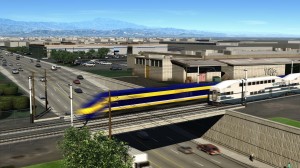After Tuesday’s groundbreaking, Eric Holthaus of Mother Jones now decides high speed rail isn’t worth it anymore:
That $68 billion California plans to spend on its high-speed rail system could buy 82,000 state-of-the-art electric buses, 55 times Greyhound’s entire nationwide fleet. And they could start operating immediately. Dedicated bus lanes and congestion pricing have done wonders for reducing commute-hell in many cities, like London. There are ways to make intercity bus travel more appealing, too, as evidenced by the expansion of carriers like wifi-enabled MegaBus in recent years. Similar “curbside” buses are the fastest growing mode of intercity transport and are the most carbon-friendly way to travel medium to long distances in the United States.
He also recommends funding self-driving cars and regulating airplane emissions. He’s motivated by the urgency of climate change:
Given the incredible pressure that global warming is inflicting, we can’t waste precious resources on high-speed rail. It’s impractical to hope that truly high-speed rail—the kind that will compete with air travel—will arrive in time to do much good.
 I appreciate Holthaus’s concern for time running out on the Earth’s climate and his willingness to search for low-cost, immediate transportation solutions. But his piece is misguided in slamming the decision to go forth with high speed rail.
I appreciate Holthaus’s concern for time running out on the Earth’s climate and his willingness to search for low-cost, immediate transportation solutions. But his piece is misguided in slamming the decision to go forth with high speed rail.
First, these aren’t “limited public transportation” funds that are being used. They are funds that were raised and dedicated solely for high speed rail. California voters in 2008 didn’t vote on a $10 billion bond initiative for 82,000 electric buses — they voted for high speed rail. Based on that political will, politicians in Washington specifically set aside stimulus funds for high speed rail (as well as electric vehicles) to help fund the system. And state politicians followed suit with cap-and-trade funds.
We can debate the wisdom of the voters and our leaders, but there’s no doubt that high speed rail is what they wanted, and they raised the funds to make it happen. In other words, high speed rail attracted its own constituency that found the funds for it. It’s not politically or legally feasible at this point to redirect those monies to other transportation forms, as Holthaus desires.
Second, there’s no reason why we can’t do what Holthaus recommends and still go forward with high speed rail. High speed rail doesn’t stop congestion pricing from happening, or more bus-only lanes, or regulation of airlines. California has an aggressive set of policies to encourage more electric vehicles, including buses. True, the cap-and-trade money that goes to high speed rail could have been used for other things. But it’s a relatively small amount of money, and a majority of those dollars go to other important greenhouse gas-reducing options. Even the stimulus, which is helping to support high speed rail, is also funding huge advancements in battery technology — which is critical for deploying more electric buses, cars, and grid storage.
Finally, Holthaus doesn’t engage with the potential greenhouse gas upsides for high speed rail. Most significantly, the system will divert the most polluting airplane trips as well as car traffic for a growing population that is already hemmed in by congestion and crowded airports. It will also entail a large investment in renewable energy to power the trains. Perhaps even more importantly, high speed rail could stimulate much more transit-oriented development in the Central Valley, which is otherwise susceptible to the same sprawl over its flat, agricultural-rich landscape that paved over the Los Angeles basin. The benefits of reducing per capita vehicle miles traveled in the Central Valley by providing an organizing infrastructure for more pedestrian and transit-friendly growth could be immense.
So while I’m sympathetic to the sentiment behind Holthaus’s arguments, I don’t think it’s fair to come out now and slam high speed rail. It’s going to happen, the money is there for it at this point, and we need to be thinking about a range of solutions to limit transportation emissions and not pit one technology against others. High speed rail is one important piece of the puzzle, and we should focus our efforts on making sure it gets built as efficiently for the taxpayers and climate as possible.
Leave a Reply
You must be logged in to post a comment.


